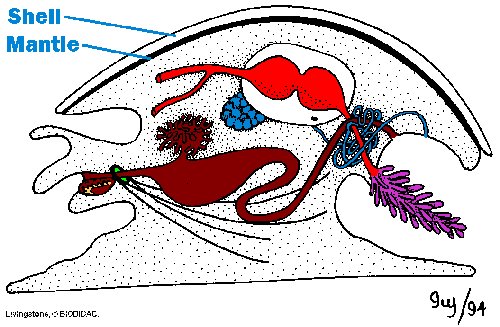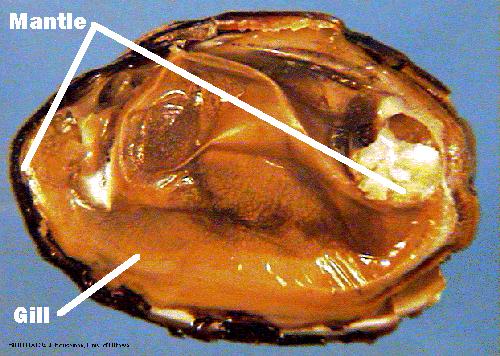Re: does a snail grow his own shell?
Date: Wed Apr 8 21:32:05 1998
Posted By: Keith McGuinness, Senior Lecturer in Zoology, NT University, Australia
Area of science: Zoology
ID: 890799918.Zo
Message:
The Question
Andrew Harrison asked:
Does a snail grow his own shell? We have search snailology books and
all available reference material.
An Answer
At last some-one has asked me a question which has a simple answer! And the answer to
Andrew's question is: "Yes, snails grow their own shells".
But perhaps Andrew would like a little more information, so...
The shell, and the tissue which makes it (the mantle), are distintive features of
animals in the Phylum Mollusca. The most diverse group of
molluscs are the gastropods (Class Gastropoda), the animals
which are commonly referred to as snails. These two key features of the molluscs probably
evolved very early in the evolutionary history of the group. Barnes, Calow & Olive have this to say:
"The dorsal protective covering of the ancestral dorsoventrally flattened mollusc
was probably a proteinaceous and chitinous cuticle reinforced by calcareous ossicles or
scales and secreted by the epidermis". (Huh?)
| What they mean by this is that the earliest molluscs (which probably
looked a bit like the animal in the drawing on the right, only simpler) probably had a
tough protective layer—the cuticle—over their back made by
their skin—the epidermis. This cuticle probably consisted of
proteins, and scales or plates made of calcium carbonate. (Calcium carbonate, CaCO3,
is the material which shells are now made of now.) You can also see that these early
molluscs probably had a simple, flat shell, like a dish. |
 Above: Drawing of a simple mollusc.
The shell and mantle are labelled. Other organ systems are: gut (brown); heart and blood
vessels (red); reproductive organs (blue); gills (purple). [Courtesy of the BIODIDAC image
library.]
|
| Over time, the scales or plates joined to become the shell
(or shells in bivalves, and plates in chitons), and the epidermis evolved to become a special
tissue—the mantle—which makes and repairs the shell. The
shell of a modern mollusc is a complex structure consisting of many different layers, some
with proteins and some without. The animal maintains the shell throughout its life and
adds to it as it grows. |
 Above: Photograph of a mussel with
one shell removed. The mantle is labelled. It lies right next to the shell. The
other large, thin tissues inside the shell are the gills (also labelled) which the animal
uses to breathe and to feed. [Courtesy of the BIODIDAC image library.] |
Finally, it is worth noting that, while the shell is a distinctive feature of the
molluscs, not all molluscs have a shell and neither do all gastropods. Two strange groups
of molluscs (the chaetodermomorphs and the neomeniomorphs) never have shells. Octopuses (one kind of cephalopod mollusc) don't have shells. And the gastropods called
"nudibranchs", "slugs" and "sea slugs" also usually lack
shells (although some slugs have a small plate).
Reference material
Books
The Invertebrates: a new synthesis,
by RSK Barnes, P Calow & PJW Olive. Blackwell Scientific Publications, 1993. This is a
university level textbook—so not suitable for "light" reading—but it
is an excellent first reference for information about invertebrates: their features,
evolution and biology.
These are the groups of molluscs recognised by Barnes, Calow & Olive. Other books
have slightly different groupings.
| PHLUM MOLLUSCA |
| Class |
Kind of animal |
| Chaetodermomorpha |
A group of strange, shell-less and worm-like animals, from 2 mm to 14 cm in length,
which live in burrows in sand and mud. |
| Neomeniomorpha |
These animals are similar in shape to the chaetodermomorphs, although they can be up
to 30 cm in length, but are carnivores feeding on cnidarians (sea anemones, hydroids,
corals). |
| Monoplacophora |
These animals were thought to be extinct until, in 1952, some were dredged up from
deep ocean trenches in the Pacific Ocean. They are all small (3 mm to 3 cm), have a
simple, dish-like and feed on material in sand or mud. |
| Polyplacophora |
These are the "chitons": animals with eight plates and common herbivore on
rocky shores around the world. |
| Gastropoda |
The gastropods are the animals known as "snails". Some are shell-less but in
those with shells, the shell can take on many elaborate shapes with curls, spines, knobs
and projections. They are most common in the sea but also live in freshwater and on land. |
| Bivalvia |
These are the clams, mussels and oysters: molluscs with two shells. |
| Scaphopoda |
The scaphopods are the "tusk shells", a name that very accurately describes
the shape of their shells (like an elephant's tusk). They are not often seen alive but
their shells are common on beaches worldwide. |
| Cephalopoda |
This group includes the squid, octopus and cuttlefish. These are undoubtedly the most
active of the molluscs and amongst the most active of all invertebrates. They are
predators, often feeding on crustaceans (crabs, lobsters and shrimp). They are also the
largest of the invertebrates—giant squid can be more than 20 m in length—and the
most intelligent. |
Links
Related questions I have answered
A few other questions I've answered for MadSci Network also have some
information about snails.
Other internet resources
This site is a large listing of sites with information about molluscs.
Keith
A. McGuinness
Senior Lecturer in Zoology
Associate Dean
School of Biological &
Environmental Sciences
Northern Territory University
Darwin, Australia
Current Queue |
Current Queue for Zoology |
Zoology archives
Try the links in the MadSci Library for more information on Zoology.
MadSci Home | Information |
Search |
Random Knowledge Generator |
MadSci Archives |
Mad Library | MAD Labs |
MAD FAQs |
Ask a ? |
Join Us! |
Help Support MadSci
MadSci Network,
webadmin@www.madsci.org
© 1995-1998. All rights reserved.

